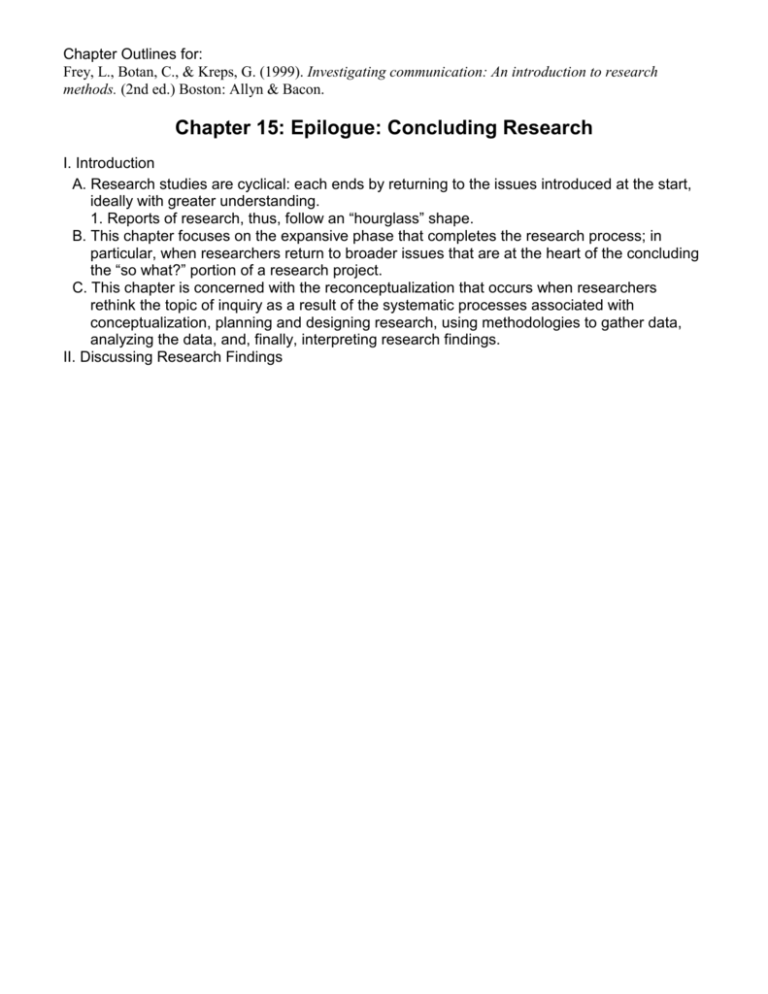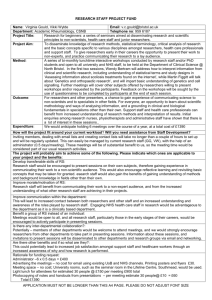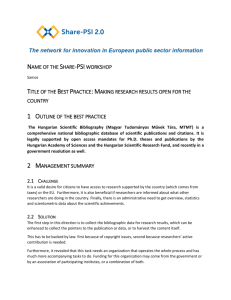Word File
advertisement

Chapter Outlines for: Frey, L., Botan, C., & Kreps, G. (1999). Investigating communication: An introduction to research methods. (2nd ed.) Boston: Allyn & Bacon. Chapter 15: Epilogue: Concluding Research I. Introduction A. Research studies are cyclical: each ends by returning to the issues introduced at the start, ideally with greater understanding. 1. Reports of research, thus, follow an “hourglass” shape. B. This chapter focuses on the expansive phase that completes the research process; in particular, when researchers return to broader issues that are at the heart of the concluding the “so what?” portion of a research project. C. This chapter is concerned with the reconceptualization that occurs when researchers rethink the topic of inquiry as a result of the systematic processes associated with conceptualization, planning and designing research, using methodologies to gather data, analyzing the data, and, finally, interpreting research findings. II. Discussing Research Findings A. In the final section of a research article (“Discussion” or Conclusion”), researchers expound on the findings and place what they found in a larger context. B. Interpreting the meaning of research findings 1. Substantive significance describes the theoretical and/or practical significance of the findings. a. Figure 15.1 illustrates the case of statistical vs. practical significance, the question of whether a research finding can be put to good use. 2. Relating findings to theory: To describe the larger meaning of the results, researchers often relate findings to theory, previous research, and expectations, and explain how the findings may be applied in relevant contexts. a. Many research studies are theory-based; attempts to disprove a concise statement that purports to explain a wide range of human behavior. b. If the findings from the theory-based study are consistent with the theory, the validity of that theory is strengthened. c. Some researchers conduct research with the expressed purpose of revising a theory so that it accounts for a wider range of phenomena. d. Sometimes researchers compare two theories that appear to be contradictory or mutually exclusive, and their findings are used to lend support to one theory or the other. e. Some communication research is oriented toward the development of new theories. 3. Relating findings to previous research: research is a cooperative enterprise; researchers attempt to interrelate their study with what others have done and, thereby, build on others’ work. a. If the results of two or more studies are consistent, the strength of both studies is bolstered. b. Comparisons to findings from other studies can also help researchers to explain their own findings. c. When researchers’ results are inconsistent with the studies of others, the discrepancy must be explained. 4. Relating findings to expectations: after analyzing the data collected for a study, researchers occasionally obtain results that are surprising or contradict their expectations. When that happens, they attempt to offer an explanation or a rationale that takes these unanticipated findings into account. a. In still other cases, the findings actually run counter to researchers’ expectations and necessitate some explanation. b. In the most extreme case, the results are so startling that they force researchers to completely reconsider their original expectations. c. Even if the findings of a study are as expected and consistent with prior research, more than one conclusion may be drawn from them; legitimately, the same research findings can be interpreted differently. d. Researchers must consider alternative explanations for their results. 5. Applying findings: Researchers tend to suggest practical uses for their findings in the discussion section, and, thereby, explore the implications that their results may have for how others can operate more effectively. a. Ideally, the findings would be beneficial to all. b. Ideally, the findings would be specific to setting, issue, and people. c. Perhaps the group that benefits the most from practical suggestions that researchers offer are practitioners, those who apply the knowledge researchers produce. d. Much communication research is directed toward studying the media, and the findings from such research often lead scholars to make recommendations to those who work in the media. e. Many communication practitioners are involved in various types of communication campaigns, such as health promotion campaigns, and researchers will assess the relative effectiveness of these campaigns and suggest modifications in the intervention programs. f. Finally, communication researchers sometimes point out important implications their findings have for public policy. 6. Identifying limitations of the research: Researcher discuss the limitations or flaws in their studies (sometimes a separate subsection, entitled, “Limitations”). a. Limitations due to internal validity threats: When research is plagued by the internal validity threats, little confidence in the conclusions is warranted. b. Researchers assess the internal validity of their findings in a number of ways: i. reporting any limitations or flaws in the study’s design ii. revealing problems or limitations with the methodological procedures researchers used iii. pointing out shortcomings in the measurement techniques used to gather data for their study and how these might potentially limit or jeopardize the findings iv. explaining the shortcomings of self-report methods v. speculating whether any unobserved or intervening variables may have confounded the results. 7. Limitations due to external validity threats: Most research is externally limited in some way, so conscientious researchers identify the context-bound limitations of their results (people, texts, events). a. Many internally valid conclusions drawn from communication studies are not necessarily generalizable. i. Sampling procedures involve the way in which the subset of the population is studied and selected. b. Many communication researchers do sample from “real-world” populations, but this does not necessarily solve the problem of acquiring representative samples. c. Some samples are better than others. d. Similar types of problems occur in the sampling of texts for textual analysis; the representativeness of the texts selected may be called into question. i. Analysts work with relatively unidentified texts in terms of who produced them, which raises concerns about their representativeness. e. Sometimes research is externally limited because of the particular event or point in time studied. f. Ecological validity is the extent to which the procedures mirror real-life situations. i. Ecologically invalid procedures may lead people to distort their behavior , overemphasizing things they typically would not do, or suppressing their normal ways of behaving. g. Replication is based on researcher awareness that a single study does not “prove” anything; indeed, many studies need to be conducted before a conclusion can be fully accepted. Thus, researchers urge that the findings from their study be replicated. C. In suggesting directions for further research and that more research needs to be done, researchers often seek to: 1. advance follow-up research questions or hypotheses 2. explain new or refined methodological procedures 3. transfer findings from laboratory experiments to the “real world” 4. extend the explanatory range of the findings 5. propose new topics D. The mission of research is fulfilled in three essential steps by: 1. making a contribution to the reservoir of communication knowledge that scholars, professionals, and the general public can call on to explain, understand, and potentially influence communication events 2. identifying important limitations that need to be kept in mind about the research findings 3. raising meaningful new questions for future communication researchers to pursue; serves a heuristic function of encouraging future investigation. III. Conclusion A. Doing research is a challenging endeavor. B. Knowledge is power. C. Through your own research efforts, you can discover, and pass along to the generation of students that will follow you, new information about what now is unknown about communication. In doing so, you will enrich their lives as countless researchers have enriched your life.





